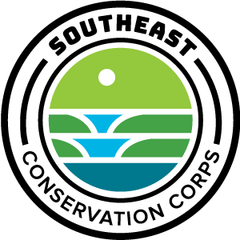The Account of Sycamore Jack and his First Hitch
BlogJake Sawyer
Crew #967
September 6, 2020
Note: The following account, in its generalities, can be considered as at least half true. Its particulars, such as names, distance, time of day, etc., should be considered woefully inaccurate and taken with their requisite grain of salt. Any metaphors, exaggerations, or other symbolic manners of speech should, of course, be accepted as the complete and literal truth, or else my name ain’t Sycamore Jack.
Now that the legalities are squarely out of the way, let’s get this thing a’rolling. By a series of winding adventures I have not ink and paper enough to relate here, I found myself signed on as a mid-season addition to the Coblin Goblins crew of the SECC. As directed, I showed up to the Chattanooga office on my first day with nothing but two bags and a sort of confused grin. Lindsey, Natalia, and James quickly commenced to fitting me out, and before I knew it, I was riding east in a SECC truck with two new shirts and an even bigger confused grin. Natalia and I drove from Chattanooga across four states, talking about standard corps topics (Ed Abbey, the corridor of sacrifice, and Puff Daddy), before arriving at the work site where I was set to join the crew midway through their hitch.

The work site itself was at Ninety-Six National Historic Site in central South Carolina. In the unlikely event you have never heard of or visited Ninety-Six NHS, it consists of a one-and-a-half square mile patchwork of forest and fields situated around Star Fort, site of the longest siege of the Revolutionary War. Wilderness is in fairly short supply—the park sits within the city limits of the modern town of Ninety Six, and you can see half a dozen houses from the visitor center porch—but the site makes up for it with its historical artifacts, including a 1780s farm house, a reconstructed fort, and some of the best-preserved earthwork fortifications in the United States. Though the camping within view of ranch-style homes does make you feel a bit like a squatter, the park’s frontcountry location does have undeniable advantages, namely a pair of plywood showers full of a dozen and 2,500 spiders, respectively.The crew had already been at Ninety Six for the previous hitch and done a lot of the work, but I was still able to join them for an hour or so of trimming that first day. There were only three of them at that point: the crew leader, Jocelyn, five feet of tough-as-nails chainsaw warrior; Kristin, a West Virginian thru-hiker and free spirit; and Alex, a Chicago theatre alum and the designated crew DJ. Add in Natalia, a tough and tender field coordinator with green hair, and me, and it was quite a bunch. We meshed immediately.
Natalia left for Chattanooga the next morning, and the crew set to work clearing out a culvert on fire roads in the park’s forest. By lunch we’d cleared it enough to switch over to doing the real Lord’s work at Ninety Six: clearing out invasive Chinese privet. We headed down into a swampy area Jocelyn called “the valley of death” and began searching the ground for the three-inch tall, waxy-leaved shoots that could turn the whole forest to an exotic monocrop if left unchecked. We had begun the slaughter and made several piles of shoots when Jocelyn brushed against a dogwood limb and made contact with a small specimen of Acharia stimulea. For those readers unversed in entomology, Acharia stimulea is colloquially known as the venomous saddleback caterpillar, and it stung Jocelyn well enough to leave the lower half of her arm swollen and throbbing. She and Alex hoofed it back to camp and were gone about an hour while she iced it, then returned. They hadn’t been back ten minutes when I startled a camouflaged copperhead the length of my arm. Reacting with characteristic calm, I hollered and jumped three feet in the air, while the snake made an equivalent dash under a fallen branch. We made the decision to let him have that area of the swamp, and we avoided the vicinity of that branch until quitting time.
On the morning after the day of venomous encounters, we got the prized job of cleaning out the 200-year-old cabin on the property, and spent the morning listening to Appalachian bluegrass while we swept up cobwebs and mouse leavings. With all our work at Ninety Six complete, we packed up camp and headed two hours west for the rare treat of a mid-hitch relocation. By early afternoon, we arrived in the Andrew Pickens District of Sumter National Forest, a swathe of public land covering the mountains along the western border of South Carolina. The partners from the forest service were Jim, a gnarled Recreation Tech with tattoos and a gray ponytail, and Jason, a clean-cut army vet who was making his way into the Forest Service as a volunteer coordinator. They settled us in at our campsite just before an evening rain rolled in, and we spent a pleasant evening enjoying the spider-free showers of the Cherry Hill Campground.
The next few days, we commenced to work in earnest. We cut back underbrush encroaching on picnic areas, beat back a wall of brambles and kudzu at a scenic overlook, and arm-wrestled rhododendron up and down the trails surrounding the Walhalla State Fish Hatchery. The work was sweaty and the brush was dense, but we were blessed with cool mountain weather and a notable shortage of snakes. A series of rainstorms passed through, and the nighttime showers took turns lulling us to sleep and flooding our tents.
We did have a few moments of excitement as well. One afternoon, we were brushing along the side of a boardwalk, doing our best to trim, keep an eye on the weather, and stay distanced from the crowds of weekend visitors. A deep gray cloud threatened to dump rain on us, but it passed over to the east without incident. I had already forgotten about it when a blinding flash came from behind, followed within seconds by am earth rattling peal of thunder. A group of kids screamed in the parking lot, Joceline hollered something I couldn’t make out, and before the rumbles had died out we were hoofing it to the van. We sat inside for a little over half an hour, but never a drop of rain or another shred of lightning did we see. We finally put it down to capricious southeast weather and went back to work.
The highlight of possibly the whole hitch, though, was the partners. Either Jim or Jason worked along with us every singe day, and each morning they brought us resupplies of ice and other necessaries. Then, on the first day at the hatchery, Jim showed up with a pair of pizzas for the crew. We declared him an all-around stand-up fellow, and made short work of both pizzas. Jason was taking notes himself, and at the end of the last day brought us not only two more pizzas, but Ben & Jerry’s as well. It made a delicious feast to wrap up the hitch.
Even though I had begun the week in a steep learning curve adjusting to the crew systems, by de-rig day the others had helped me get up to speed, and we cleaned tools and broke camp cleanly and efficiently. We were out of the campground by 7:00 a.m., and Alex poured on a string of alt-rock and oldies to carry us through the drive home. For a greenhorn like myself, it was a grand first hitch, with some fine new friends and a few good stories to show for it. And the best part is, most of them actually happened.
Stay natural,
Sycamore Jack





